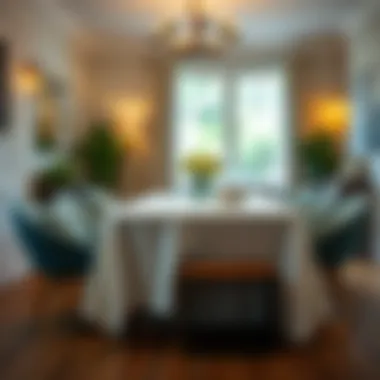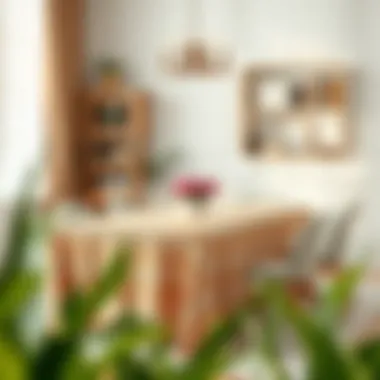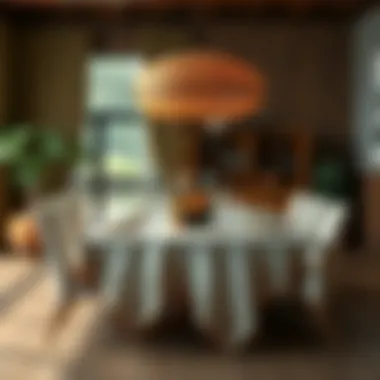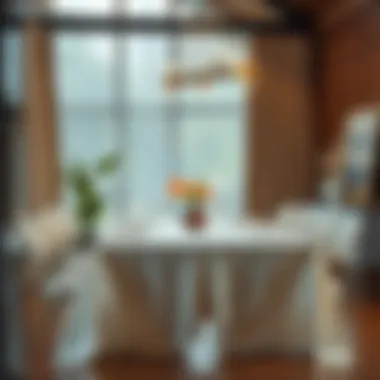Choosing Tablecloths for Rectangular Tables: Tips & Trends


Intro
Tablecloths are more than mere pieces of fabric tossed onto a table. They play an essential role in our homes, providing both aesthetic appeal and functionality. Rectangular tables are often the centerpiece of dining rooms or kitchens, making the choice of tablecloth paramount in setting the mood and defining the space. The right tablecloth can transform a simple gathering into an elegant dining experience, enhancing the beauty of the table while protecting its surface.
As we delve deeper into the topic, we’ll explore a range of considerations that go into selecting and using tablecloths tailored for rectangular tables. From understanding different materials and designs to matching linens with occasions and themes, we'll cover it all. Seasonal trends, care tips, and maintenance will also be discussed, ensuring that every step in the process is considered.
Furniture Styles and Trends
Modern vs. Traditional: Understanding the Aesthetics
The world of tablecloths is brimming with styles that resonate with various furniture aesthetics. When it comes to modern designs, think minimalism and clean lines. Shades of gray, white, and bright bold colors are often highlighted, aligning with sleek table designs. For instance, a solid, monochromatic tablecloth can serve to underscore a striking glass or metal table, allowing the furniture's design to shine while providing a contemporary backdrop.
Conversely, traditional styles hark back to more ornate times. Fabrics adorned with intricate patterns, lace trimmings, or classic checks can be ideal for wooden tables, evoking warmth and nostalgia. A paisley-printed tablecloth can really complement a rich mahogany finish, creating a sense of timeless elegance. Choosing the right style not only decorates the table but also creates a coherent aesthetic throughout the space—keeping in harmony with the existing decor is key.
Color and Material Trends: What's In and What's Out
Color plays a vital role in setting the ambiance of any dining environment. In recent times, earthy tones such as terracotta, olive green, and rustic browns have gained popularity. These colors tend to bring a touch of nature indoors, adding warmth and richness. On the flip side, brighter hues tend to be favored during warmer months when outdoor dining is in vogue—think vibrant yellows and refreshing aquas that capture the spirit of summer gatherings.
Material selection is crucial as well. Natural fibers such as cotton and linen are perennial favorites, appreciated for their durability and breathability. Meanwhile, synthetics can offer easy maintenance and vivid colorations that hold up over time. When selecting materials, one must also consider the setting—an outdoor picnic may call for something more robust, whereas a formal dinner might warrant delicate fabrics.
Choosing the right tablecloth is not just a matter of aesthetics; it’s about weaving together style, function, and the essence of your living space.
Furniture Care and Maintenance
Tips for Prolonging the Life of Your Furniture
While selecting a tablecloth is important, ensuring your furniture stands the test of time is equally vital. Proper care can prolong the life of your dining table:
- Avoid direct sunlight. Keep furniture out of harsh sunlight to prevent fading.
- Clean regularly. Dust and wipe surfaces regularly to avoid build-up that can damage the finish.
- Use coasters and placemats. Protect surfaces from heat and moisture with protective gear.
DIY Repair Hacks for Common Furniture Issues
Even with the best care, furniture can suffer wear and tear. Thankfully, many common issues can be resolved with simple home remedies:
- Nicks and scratches can be colored in using a walnut—just rub it on the blemish.
- Water rings can be lifted by applying a mix of olive oil and vinegar, gently buffing it into the surface.
- Loose legs may simply need tightening; use a wrench to secure any wobbly furniture.
By understanding these elements, homeowners, designers, and DIY enthusiasts alike can curate their tablecloth selections with a sharp eye for both style and longevity. The world of table linens is dynamic, influenced by trends and personal taste, which makes the process of selection all the more engaging.
Prologue to Tablecloths for Rectangular Tables
Tablecloths play a pivotal role not just as functional pieces in our homes, but also as key elements that define the ambiance of a dining space. For homeowners, designers, and enthusiasts alike, understanding the ins and outs of tablecloths tailored for rectangular tables is essential. These coverings are far more than mere fabric; they serve as a canvas on which both function and aesthetics coexist.
Choosing the right tablecloth can effectively transform a mundane dining area into something enchanting. This selection impacts not only the look of the space but also the overall dining experience. A well-chosen tablecloth can protect surfaces from scratches and stains, prolonging the life of the furniture beneath. Many of today’s tablecloths are designed not just for protection but also to enhance visual appeal, harmonizing with the decor or making a bold statement.
Key Considerations When Selecting Tablecloths:
- Material Matters: Each fabric comes with its own set of pros and cons. Natural fibers like cotton offer style and comfort, while synthetics lend durability.
- Design Impact: A simple solid color may exude elegance, while bold patterns can inject vitality into the room. Understanding color theory and design elements can guide choices that resonate with personal style.
- Event Relevance: Different occasions call for different atmospheres. A casual family dinner doesn't require the same decor as a formal event.
For anyone who enjoys hosting or simply wants to create a welcoming environment, grasping these essential elements is crucial. The interaction between style, practicality, and personal preferences creates an intricate tapestry of choices that can elevate any room’s design.
As we progress, we will delve deeper into the various materials suitable for tablecloths, exploring their unique benefits and potential drawbacks.
"The right tablecloth doesn’t just cover; it elevates, transforms, and protects."
Understanding these facets ensures that every dining experience can be tailored to meet both aesthetic and functional needs. Tile your rectangular tables with fabric that resonates with your style, while serving its purpose behind the scenes.
Material Variations
The choice of materials for tablecloths is not just a matter of aesthetic preference; it has significant implications for functionality, care, and the overall atmosphere of a dining area. A well-chosen tablecloth will not only protect the surface of a rectangular table but also contribute to the ambiance of the space. Different materials offer various benefits and considerations that can enhance or detract from the intended purpose of a tablecloth. Understanding these material variations empowers homeowners, designers, retailers, and DIY enthusiasts to make informed decisions that align with their needs and personal style.
Cotton and Linen
Benefits of Natural Fabrics
Natural fabrics like cotton and linen come with a host of advantages that make them a preferred choice for many. First and foremost, breathability is a standout characteristic. Unlike synthetic fibers, cotton and linen allow air to circulate, which can help maintain a comfortable dining atmosphere. Additionally, their soft texture offers a warm feel against the skin, making dining more inviting. Linen, in particular, has a natural luster that adds elegance to any table setup.
Another benefit is the eco-friendly aspect of these materials. As they are derived from natural sources, they are biodegradable and often produced with fewer chemicals compared to man-made fabrics. Folks who are environmentally conscious will find this appealing. Linen's ability to resist dirt and static also adds to its charm, making it easier to manage during everyday use.
Potential Drawbacks
However, investing in natural fabrics comes with some caveats. One of the main drawbacks is their susceptibility to wrinkles. Sure, a little bit of wear can add character, but nobody enjoys battling a crinkled tablecloth before guests arrive. Additionally, cotton can absorb stains like nobody's business, often requiring more tedious laundering. For busy homeowners or those less inclined toward frequent cleaning, this might feel like a hassle.
Another point to consider is the potential cost. High-quality cotton and linen tablecloths may come with a heftier price tag than synthetic options. A budget-conscious buyer might hesitate, especially if they view tablecloths as temporary items. The overall durability of these fabrics is also something to weigh—whereas they can last long with proper care, they can be less forgiving than synthetic fabrics in the hustle and bustle of daily life.
Synthetic Materials


Durability and Care
Synthetic materials, such as polyester and nylon, can be a game-changer in the realm of tablecloths. One of the most appealing aspects is their durability. Unlike their natural counterparts, synthetic fibers are often resistant to tearing and wear, making them suitable for cases of heavy use. Furthermore, they often resist stains and spills remarkably well, which can be a boon during casual gatherings or family meals.
In terms of care, synthetic tablecloths are typically machine washable and less prone to wrinkling. This means less time spent prepping and maintaining your décor, allowing for a more enjoyable dining experience. People looking for convenience without sacrificing style may find synthetic options to be a worthy investment.
Cost-Effectiveness
When it comes to cost, synthetic materials hold a distinct advantage. They are generally more affordable, allowing for wider variety and easier replacement. For individuals or families that like to change things up often or those hosting regular events, this cost-effectiveness is particularly attractive.
However, some may find that while synthetic materials are budget-friendly, they are sometimes perceived as lacking the charm and warmth of natural fabrics. This can leave homeowners torn between aesthetics and practicality—after all, the right tablecloth can define a dining space, and choosing solely based on cost could lead to regret.
Waterproof Options
Ideal for Outdoor Use
Waterproof tablecloths serve a specific and beneficial niche, especially for those who entertain outdoors. These materials are designed to withstand moisture, be it from spilled drinks or unexpected rain showers. This feature makes them invaluable for patio dining setups, barbecues, or poolside gatherings. They often come in appealing colors and designs, ensuring that function doesn’t overshadow aesthetics.
The ease of wiping clean is another appealing characteristic. Rather than fretting over damage from spills, homeowners can focus on enjoying the company of guests. Plus, being able to let loose without worrying about maintaining pristine conditions adds significant value to the overall dining experience.
Variety of Styles
Contrary to the perception that waterproof options are strictly utilitarian, makers have vastly improved upon the styles available. From bold patterns to elegant finishes, the variety of styles provides ample room for personal expression. Whether one prefers a sun-drenched tropical motif or a classic checkered print, the options are extensive.
This means that homeowners can align their table settings to seasonal themes or personal tastes without needing to compromise on the practicality aspect. However, the challenge could arise from a mismatch with indoor decor, so consideration of overall style remains crucial.
Design Considerations
When it comes to selecting tablecloths for rectangular tables, design considerations play a pivotal role. It’s not merely about protecting your table or matching colors; it’s about creating an atmosphere that resonates with the intended function of the space. Design elements like color, patterns, and seasonal appropriateness can swiftly transform a mundane meal into a memorable dining experience.
Color Theory
Matching Room Decor
Matching a tablecloth with the room decor is a fundamental aspect that shouldn’t be overlooked. A well-chosen tablecloth can either blend seamlessly with the existing decor or provide a striking contrast, enhancing the overall aesthetic impression of the space. For instance, if the kitchen features deep blue hues, selecting a tablecloth with accents of blue can create a harmonious look that feels cohesive.
One key characteristic of this approach is its ability to elevate the ambiance. A matching tablecloth often fosters a sense of order and unity in design. If chosen wisely, this can also draw focus on elements of the room that deserve attention, like a unique light fixture or art piece. However, a potential drawback might be the risk of the space feeling monotonous if the designs are too similar or lacking in variety.
Impact on Mood
The colors you choose for tablecloths can significantly affect the mood of a dining experience. For example, vibrant hues such as red or yellow can invoke feelings of warmth and excitement, making them ideal for festive gatherings. Conversely, muted tones like soft blues or greens can create a tranquil environment suited for intimate dinners. Understanding color psychology helps in selecting not just what looks good, but what can influence how guests feel as they enjoy their meal.
A unique feature of considering color impact is its effectiveness in aligning the setting with the specific occasion. If you’re hosting a birthday dinner, lively colors can lift spirits. But, if it’s a more formal event, subdued tones may encourage a serene atmosphere. The downside? Overlooking the mood element may lead to an uninspired experience that doesn’t resonate with guests.
Patterns and Textures
Creating Visual Interest
Introducing patterns and textures can add layers to table settings, enriching the visual narrative. For example, a floral patterned tablecloth can provide a cheerful presence, especially during spring. The use of textures, like linen, can enhance the tactile experience, enticing guests even before they sit down.
A noteworthy advantage of utilizing this approach is the capacity to draw the eye. A well-designed tablecloth with engaging visuals can serve as an attractive focal point, enhancing even the simplest of meals. However, one must tread carefully; overly complex patterns may clash with other decor elements in the room, leading to a disjointed look.
Combining with Other Decor
Combining tablecloths with other decor elements, such as plates and centerpieces, is a strategic approach to achieve an overarching theme. If you have an elegant glass centerpiece, choosing a finely detailed, embroidered tablecloth can amplify the drama of the setting.
The distinctive feature of this strategy is its flexibility; it allows for creative expression that reflects the host’s personality. A thoughtfully selected combination can make even everyday meals feel special. Nonetheless, be wary of mixing too many different styles, as this can lead to a crowded table that overwhelms the eyes rather than pleasing them.
Seasonal Trends
Seasonal Color Palettes
Incorporating seasonal color palettes into your tablecloth selection can breathe life into your dining space throughout the year. Spring often calls for fresh greens and pastel tones, while autumn invites rich oranges and browns. This aligns your decor with the natural rhythm of the seasons and can make meals feel more relevant and timely.
A major benefit of embracing seasonal palettes is their ability to create a lasting impression. They represent the changing times, helping guests feel connected to nature’s cycles. However, adhering strictly to seasonal trends may have its drawbacks; it could lead to a tedious rotation that feels forced rather than organic.
Festive Themes
When it comes to festive themes, the right tablecloth can set the stage perfectly for celebrations. Think red and green during Christmas or pastel colors for Easter. A themed tablecloth not only complements decorations but also enhances the emotional significance of the occasion.
A key characteristic of festive themes is their unifying quality. They bring together disparate parts of the decor into a cohesive whole. However, relying too heavily on a specific theme might limit versatility, as it may restrict the use of such tablecloths outside of a particular holiday or occasion.
Functionality and Practical Use
When it comes to selecting tablecloths for rectangular tables, functionality and practical use are paramount. Tablecloths not only serve as decorative elements but they also play critical roles in the protection of surfaces and the enhancement of dining experiences. Understanding these practical aspects can help homeowners and designers alike make informed selections that contribute not only to aesthetic appeal but also to durability and convenience.
Protection of Surfaces


-#### Preventing Scratches
One of the significant benefits of using tablecloths is their ability to prevent scratches on wooden or glass surfaces. Tables are often the centerpiece of dining areas and workstations, facing daily wear and tear from utensils, laptops, and other items. Covering them with a tablecloth acts as a buffer against these potential sources of damage. This protective layer means that small items like coffee cups or forks won’t directly interact with the table, which is especially important for those who cherish heirloom furniture.
A good quality tablecloth minimizes the risks of scratches and dents, safeguarding your investment in furniture. It’s a popular choice for families with children or when entertaining guests because it helps maintain the integrity of the table while also creating a more relaxed atmosphere. The downside, however, is that frequent washing and general use can still wear down even a strong fabric over time, which is something to keep in mind.
-#### Stain Resistance
Another pivotal feature to consider is stain resistance. Dining tables see spills, drips, and crumbs as part and parcel of everyday life. A stain-resistant tablecloth serves as a first line of defense against red wine, sauce, or any unexpected accidents that may occur during meals. This characteristic makes it a wise choice—especially for busy households.
Many modern tablecloths come with built-in stain-resistant treatments, making them easier to clean and maintain. They repel liquids, allowing spills to sit on the surface long enough to be wiped off, rather than soaking into the fabric itself. This practical approach not only provides a sense of reassurance but extends the aesthetic life of the cloth as well. Conversely, one must ensure that heavily soiled fabrics with stain resistance are still washed properly to preserve this quality, which can sometimes be a hassle, depending on the material.
Enhancing Dining Experiences
-#### Setting the Mood
The impact of a tablecloth on setting the mood for a meal cannot be overstated. The ambiance of a dining area plays a significant role in how interactions unfold, whether it’s a casual dinner with family or an elegant gathering with friends. A well-chosen tablecloth can elevate the dining experience, making even the simplest of meals feel more special. The right colors and fabrics can induce feelings of warmth, sophistication, or celebration, clearly influencing the atmosphere of the gathering.
This transformative power makes tablecloths an essential consideration in dining decor. For instance, using a soft, muted fabric can create a relaxed environment, while bold patterns might energize the space. The only drawback could be the potential mismatch with other elements of decor if not thought through properly, which could tarnish the desired mood.
-#### Formal vs. Informal Settings
Differentiating between formal and informal settings is crucial when choosing a tablecloth. For instance, a crisp white linen tablecloth may communicate elegance at a wedding or a holiday feast, while a vibrant, patterned cloth may be more suitable for a casual family gathering or barbecue. Tailoring your choice to the occasion also speaks volumes about hospitality and attention to detail.
Formal settings often call for more refined materials, such as silk or richly woven fabrics, providing a certain gravity to the dining experience. In contrast, informal settings can embrace flexibility—allowing for creative designs that may even incorporate seasonal themes. That said, an inappropriate tablecloth can lead to a confused aesthetic, distracting from the charm of the event.
Ease of Cleaning and Maintenance
-#### Washing Guidelines
An important aspect of practicality is the washing guidelines for tablecloths. Knowing how to properly care for your tablecloth can extend its life substantially. Many fabrics have specific washing instructions that can vary significantly. For example, cotton tablecloths can often be machine washed, while delicate fabrics like satin may require hand washing or dry cleaning.
Following the manufacturer's instructions not only helps in maintaining the appearance of the fabric but also ensures that any stain-resistant treatments remain effective. Neglecting this can lead to colors fading or textures becoming rough over time. Therefore, proper cleaning protocols are essential, especially for those who regularly entertain or have children.
-#### Storage Tips
Finally, well-executed storage tips can preserve the quality of tablecloths when they’re not in use. Storing tablecloths correctly avoids wrinkles and prevents damage from environmental factors. For example, folding tablecloths neatly and keeping them in a cool, dry, and dark place can help maintain their good condition. Avoiding damp areas and direct sunlight is critical to prevent mold and fading.
Furthermore, using breathable fabric bags rather than plastic keeps humidity at bay, allowing linens to breathe and reducing the risk of mildew. Storage might seem secondary to usage, but it’s a cornerstone of longevity and can make a big difference in their visual appeal when retrieved for the next occasion.
Understanding the practical aspects of tablecloth usage—such as surface protection, enhancing dining experiences, and efficient care—can significantly improve the selection and enjoyment of table linens for rectangular tables.
Matching Tablecloths to Events
Choosing the right tablecloth for a specific event is vital. It is not just about aesthetics; it ties in deeply with the theme, formality, and overall feel of the occasion. Selecting an appropriate tablecloth can set the stage for gatherings, whether it be a mundane Tuesday dinner or a lavish wedding reception. The right choice can elevate dining experiences, making them feel more special and intentional.
Everyday Use
Choosing for Daily Meals
When it comes to choosing tablecloths for everyday meals, practicality reigns supreme. A tablecloth that withstands the daily wear and tear is essential. Cotton blends or easy-care synthetics often fit the bill. They provide a balance between comfort and durability. A tablecloth should not just look good; it should handle spills and everyday life. Families with children often prefer patterns or darker colors - these can mask minor stains and mess. It's a functional choice that still allows for a touch of style in the dining area.
The unique feature of using tablecloths for daily meals is the ease of maintenance. Many are machine washable, which fits perfectly into a busy lifestyle. This practicality is what makes this choice a mainstay for homeowners who want to keep their dining space looking inviting without spending hours on upkeep.
Functional Simplicity
Functional simplicity cannot be overstated. A tablecloth that serves its purpose without unnecessary frills is often the most appreciated during daily use. It covers the table but doesn’t dominate the space. Clean lines and solid colors often provide versatility, lending the ability to dress up or down for different occasions easily.
This straightforward approach allows the table’s natural beauty to shine through while protecting it from damage. Additionally, simpler tablecloths can easily blend with varied dishware or centerpieces, making it a solid choice for many homeowners. A practical triumph that adds value to a dining setup, simplicity in design can often translate to timeless elegance.
Special Occasions
Designing for Parties
When throwing a party, the tablecloth becomes a vehicle for creativity. It’s not merely a cover; it’s a statement piece. Bright colors, lively patterns, and sometimes even themed designs contribute significantly to the mood of the gathering. Whether hosting a birthday bash or a festive holiday gathering, the tablecloth can reflect the theme and vibe you wish to create. This brings life to the event, enchanting guests as they settle in.
A unique advantage of designing for parties is the endless array of options available. From sequined tablecloths that offer glamour to rustic burlap that infuses warmth, choices abound that fit varied themes. However, it's worth noting that bold choices might not always align with others' preferences, perhaps making some guests feel out of place.
Theme-Based Decor
Incorporating theme-based decor transforms the dining experience into something memorable. It can be fun to align the tablecloth with the event theme, be it a vintage tea party or a modern chic night. The tablecloth often becomes the backdrop against which food, drinks, and conversations happen. An engaging theme can lead guests to dive deeper into the atmosphere, creating shared experiences around the dining table.
The key characteristic of a well-chosen theme-based tablecloth is its ability to evoke immediate feelings associated with the theme, be it elegant, playful, or nostalgic. However, it’s wise to ensure it harmonizes with all utensils and centerpieces planned for the event, as a disjointed look might dilute the intended effect. In the end, theme-based tablecloths serve as a conversation starter while enhancing the overall ambiance.
Seasonal Celebrations
Tailoring Linens to Holidays
Tailoring linens to fit different holidays is a fascinating aspect. It allows for a celebration that honors tradition while embracing creativity. Christmas-themed tablecloths featuring reds and greens often bring warmth, while autumn-themed linens in shades of orange and brown set the tone for Thanksgiving gatherings. Each season tells a story, and tablecloths play their part in narrating this tale through color and texture.
One of the most appealing aspects of tailored holiday linens is the personalization they offer. Family heirloom tablecloths can be showcased during holidays, sparking nostalgia and conversation among guests. However, these choices can sometimes be seasonal exclusives, limiting everyday use.
Creating Festive Atmosphere
Creating a festive atmosphere is at the core of any celebration. Here, the tablecloth takes center stage in not just setting the mood but also enhancing it. An enticing table setting can immediately signal to guests that something significant is taking place. Whether it’s a vibrant surface for a spring brunch or a shimmering cloth for a New Year’s Eve soirée, the impact is undeniable.
The unique feature of employing tablecloths in this manner is their ability to transform the ordinary into the extraordinary. However, caution is suggested; overly extravagant designs might overwhelm simpler decor elements. Remember, sometimes less really is more, especially when serving a culinary feast. Balancing festivity with simplicity can result in memorable celebrations without the risk of visual overkill.


"The right tablecloth can turn a simple meal into a memorable feast. It’s these details that often linger with guests long after the dishes are cleared."
Ultimately, aligning tablecloths with events bridges the gap between functional dining and aesthetically pleasing presentations. It’s this synergy that fosters a warm dining atmosphere, ensuring memorable gatherings, regardless of their nature.
Cultural Influences on Tablecloth Choices
Understanding the cultural influences on tablecloth choices reveals a tapestry of tradition and functionality. Across various regions, tablecloths serve not just as decor but also embody deeper meanings rooted in history and societal norms. The selection of tablecloths can signify celebrations, mourning, or everyday living, making the examination of these influences pivotal for homeowners, designers, and enthusiasts alike.
Regional Styles
Examining Global Practices
When one looks at the different global practices regarding tablecloths, it becomes clear that these linens are more than mere fabric. For instance, the Japanese have a rich heritage of using furoshiki, which are versatile cloths for wrapping goods. This reflects a minimalist aesthetic and a respect for the environment. Such practices highlight the importance of tablecloths as multifunctional items that serve various roles in daily life. Using these traditional approaches can give a lovely nod to sustainability, encouraging modern consumers to think carefully about their choices. The beauty of Japan’s folding art, for example, lies in its simplicity and utility, making it a standout in an era increasingly focused on eco-conscious living.
Cultural Symbols in Table Decor
Cultural symbols also play a significant role in table decor. In many cultures, the use of specific colors or motifs signifies various facets of life. For example, in Indian culture, the vibrant colors and intricate patterns often found on tablecloths during festivals symbolize joy and prosperity. This adds layers of meaning to the dining experience, transforming a simple meal into a celebration of culture and tradition. The downside, however, might be the cultural specificity of these designs. For those not familiar with the symbols, there can be a risk of misinterpretation, but understanding them can lead to a more enriching experience.
Traditional vs. Modern Aesthetics
Blending Design Approaches
When it comes to design, the blending of traditional and modern approaches offers a refreshing take. This fusion can create an inviting atmosphere that appeals to a wide audience. Traditional tablecloths, like lace from Italy or embroidered pieces from Eastern Europe, bring nostalgia and warmth, while modern graphics integrate a fresh twist. The mix can bridge generations, making gatherings feel inclusive, regardless of age. However, achieving balance is key; too much of one style can overwhelm the other.
Contemporary Trends
Examining contemporary trends in tablecloth design reveals a shift toward minimalism and functionality. Many modern tablecloths feature geometric patterns or abstract designs, focusing on clean lines and simplicity. This approach caters to today’s fast-paced lifestyle, where practicality sometimes trumps ornamentation. These designs often come in easy-to-care-for materials that appeal to busy homeowners. However, this trend might sacrifice some of the personal touches that traditional tablecloths provide. Striking the right balance ensures that modern designs do not completely overshadow the rich narratives of cultural heritage.
In summary, the cultural influences on tablecloth choices present a fascinating intersection of tradition, symbolism, and design. Understanding these influences equips individuals with the knowledge to make informed choices, enhancing both their dining experiences and the aesthetics of their living spaces.
The Role of Tablecloths in Sustainability
As environmental concerns continue to grow, the role of tablecloths in sustainability has become more significant. Choosing tablecloths made from eco-friendly materials not only adds to the aesthetic of your dining experience but also has an impact on our planet. Sustainable tablecloths can reduce waste, minimize the carbon footprint, and promote responsible consumer behavior.
Eco-Friendly Materials
Sustainable Options Available
When we talk about sustainable options for tablecloths, we usually think of fabrics made from materials that are harvested with minimal environmental impact. Options include organic cotton, hemp, and even bamboo. These materials are grown without synthetic pesticides or fertilizers, allowing for healthier ecosystems. Moreover, organic cotton, for example, is particularly popular due to its softness and durability.
One key characteristic of sustainable tablecloths is their biodegradability. Unlike synthetic counterparts, these natural materials break down over time, thus reducing landfill waste. The unique feature of eco-friendly fabrics is that they also tend to support local economies, as many are produced by smaller farms and businesses. This not only ensures quality but encourages ethical practices in the sourcing of textiles.
However, it’s important to consider some potential drawbacks. Sustainable options may sometimes come with a higher price tag, which can deter some consumers. Still, the long-term benefits in terms of durability and environmental impact often outweigh this initial investment.
Benefits of Organic Fabrics
Organic fabrics offer several advantages that enhance their appeal as sustainable choices in tablecloth selection. Primarily, they are free from harmful chemicals, which is a boon for not only the environment but also human health. This characteristic makes them a wise choice for dining settings, particularly where children or individuals with allergies may be present.
Another attractive aspect of organic tablecloths lies in their softness and breathability, ensuring they feel comfortable against the skin. They also often have unique aesthetic qualities, with natural textures and colors that cannot be replicated by synthetic fibers. Yet, keeping in mind that organic fabrics may require gentle washing practices to maintain their integrity is essential.
Long-Term Investment
Quality vs. Fast Fashion
In the arena of table linens, the choice between quality and fast fashion is crucial. Opting for well-made, quality tablecloths can provide a long-lasting solution that ultimately saves money and reduces waste. Fast fashion products are often designed with a short lifespan, leading to frequent replacements and contributing to environmental degradation.
Quality tablecloths typically use durable materials that withstand the test of time. They tend to be more expensive upfront, but their longevity pays off in the long run. The unique characteristic here is their ability to endure repeated washings without losing shape or color.
In contrast, fast fashion may appeal to those wanting something trendy at a low cost. Yet, in the end, they add to the landfill problem, as they are often tossed out after a few uses due to their poor quality.
Longevity Factors
Longevity is often influenced by a variety of factors like fabric type, thread count, and care instructions. Higher quality materials maintain their look and feel over time, reducing the need for replacements. For instance, cotton blends or twill weave often resist wrinkles and fading better than cheaper alternatives.
Additionally, proper care is fundamental to extending the life of a tablecloth. Following washing guidelines, like avoiding high temperatures and harsh detergents, can ensure your table linen remains vibrant for years. Choosing versatile designs enhances longevity as well, as a tablecloth that complements a range of occasions can be more frequently utilized, thus justifying the expense.
Overall, opting for sustainable tablecloths is not just a choice—it's an investment in your home, your health, and the planet. By understanding the importance of material selection, quality considerations, and the environmental impact of our consumer choices, one can make informed decisions that echo both style and responsibility.
The End
In summing up the journey through the world of tablecloths for rectangular tables, it’s clear that the choices one makes in selecting these linens can greatly influence both function and aesthetics in any living space. Tablecloths serve multiple purposes: protecting surfaces, defining a space, and setting a particular mood for various occasions.
When considering the selection of tablecloths, one should keep in mind several key factors. First, the material plays a pivotal role in both durability and care. Natural options like cotton and linen add a touch of elegance, while synthetic fabrics offer more ruggedness and straightforward maintenance. Design elements such as color theory and patterns not only enhance the visual appeal but also interact with the ambiance of the room, looking to make spaces feel cozier or more sophisticated.
The practical use of tablecloths cannot be overlooked. Whether you are hosting a casual gathering or a formal dinner, the right tablecloth helps to elevate dining experiences. For the everyday table with crumb spills and drink rings, the requirement leans towards ease of cleaning and durability rather than visual flair. In contrast, special occasions may call for dreamy fabrics drenched in joyful colors and intricate designs, reflecting the spirit of celebration.
Understanding the cultural influences also adds depth to the tablecloth choice. Global perspectives can showcase traditional styles, while modern trends often push for minimalist aesthetics, leading to a unique blend that resonates with individual taste.
Finally, as sustainability becomes a growing concern for many homeowners, it’s essential to think about eco-friendly materials and long-term investment when selecting table linens. Opting for durable, environmentally responsible options not only enhances personal style but also fosters a gentler impact on the planet.
Choosing the right tablecloth is more than just about looks; it’s about functionality, cultural resonance, and contributing positively to one’s environment. By thoughtfully considering each of these elements, individuals can create spaces that are not only beautiful but also truly livable.
"A tablecloth can transform a simple meal into a dining experience that invites conversation and connection."















